Related Research Articles
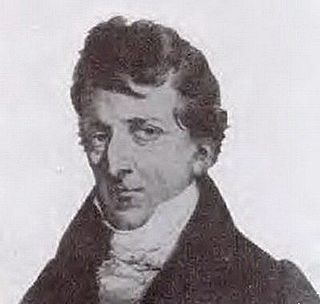
Giovanni Aldini, was an Italian physician and physicist born in Bologna. He was a brother of a statesman.

Tyburn was a village in the county of Middlesex close to the current location of Marble Arch and the southern end of Edgware Road in present-day London. It took its name from the Tyburn Brook, a tributary of the River Westbourne. The name Tyburn, from Teo Bourne means 'boundary stream', but Tyburn Brook should not be confused with the better known River Tyburn, which is the next tributary of the River Thames to the east of the Westbourne.

Tom King was an English highwayman who operated in the Essex and London areas. His real name is thought to have been Matthew King; whether "Tom" was a nickname or an error in reporting his crimes is uncertain, but it is the name by which he has become popularly known. Some sources claim that he was nicknamed "The Gentleman Highwayman" and he was also known as “Captain Tom King”. A contemporary account of his last robbery also mentions a brother, either John or Robert King, who was captured by the authorities on that occasion. Other reports also mention an “Elizabeth King”, possibly his wife who is mentioned in King's will.

A highwayman was a robber who stole from travellers. This type of thief usually travelled and robbed by horse as compared to a footpad who travelled and robbed on foot; mounted highwaymen were widely considered to be socially superior to footpads. Such criminals operated until the mid or late 19th century. Highwaywomen, such as Katherine Ferrers, were said to also exist, often dressing as men, especially in fiction.

Jack Sheppard, or "Honest Jack", was a notorious English thief and prison escapee of early 18th-century London. Born into a poor family, he was apprenticed as a carpenter but took to theft and burglary in 1723, with little more than a year of his training to complete. He was arrested and imprisoned five times in 1724 but escaped four times from prison, making him a notorious public figure, and wildly popular with the poorer classes. Ultimately, he was caught, convicted, and hanged at Tyburn, ending his brief criminal career after less than two years. The inability of the notorious "Thief-Taker General" Jonathan Wild to control Sheppard, and injuries suffered by Wild at the hands of Sheppard's colleague Joseph "Blueskin" Blake led to Wild's downfall.
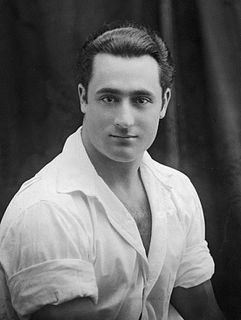
Charles Atlas was an Italian-American bodybuilder best remembered as the developer of a bodybuilding method and its associated exercise program which spawned a landmark advertising campaign featuring his name and likeness; it has been described as one of the longest-lasting and most memorable ad campaigns of all time.

Elizabeth Canning (married name Treat; 17 September 1734 – June 1773) was an English maidservant who claimed to have been kidnapped and held against her will in a hayloft for almost a month. She ultimately became central to one of the most famous English criminal mysteries of the 18th century.

Hugh Roe O'Donnell, also known as Red Hugh O'Donnell, was a sixteenth-century Irish nobleman. He became ruler of Tyrconnell in 1593 after a succession dispute among the O'Donnell dynasty, and after escaping a five-year imprisonment in Dublin Castle by the English. Along with his father-in-law Hugh O'Neill of Tyrone, he led the Irish alliance in the Nine Years' War against the English government in Ireland. Hugh Roe led an Irish army to victory in the Battle of Curlew Pass. After defeat in the Siege of Kinsale, he travelled to Spain to seek support from Philip III. Unsuccessful, he died in Spain and was succeeded by his younger brother Rory O'Donnell. He is sometimes also known as Aodh Ruadh II or Red Hugh II, especially in his native County Donegal.
Pudd'nhead Wilson (1894) is a novel by American writer Mark Twain. Its central intrigue revolves around two boys—one, born into slavery, with 1/32 black ancestry; the other, white, born to be the master of the house. The two boys, who look similar, are switched at infancy. Each grows into the other's social role.

The Spectator was a daily publication founded by Joseph Addison and Richard Steele in England, lasting from 1711 to 1712. Each "paper", or "number", was approximately 2,500 words long, and the original run consisted of 555 numbers, beginning on 1 March 1711. These were collected into seven volumes. The paper was revived without the involvement of Steele in 1714, appearing thrice weekly for six months, and these papers when collected formed the eighth volume. Eustace Budgell, a cousin of Addison's, and the poet John Hughes also contributed to the publication.
Alice Arden (1516–1551) was an English murderer. She was the daughter of John Brigantine and Alice Squire, who conspired to have her husband, Thomas Arden of Faversham, murdered so she could carry on with a long-term affair with a tailor, Richard Moseby. The murder took place on 14 February 1551. She was tried, convicted, and burnt at the stake for her part in the murder.
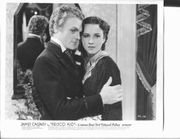
Frisco Kid is a 1935 film starring James Cagney and directed by Lloyd Bacon.

Yellow Sky is a 1948 American western film directed by William A. Wellman and starring Gregory Peck, Richard Widmark, and Anne Baxter. The story is believed to be loosely adapted from William Shakespeare's The Tempest. The screenplay concerns a band of reprobate outlaws who flee after a bank robbery and encounter an old man and his granddaughter in a ghost town.
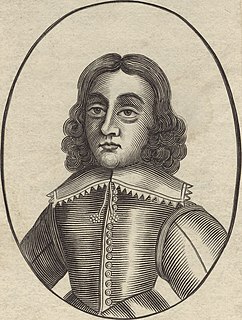
James Hind was a 17th-century highwayman and Royalist rabble rouser during the English Civil War. He came from the town of Chipping Norton, Oxfordshire. He fought in the English Civil War for the Royalist cause, some reports tell of him assisting the escape of King Charles II after his defeat at the Battle of Worcester. After the war, he took up highway robbery against the Commonwealth forces with his exploits both real and embellished printed in numerous pamphlets that made him into a Royalist folk hero of the Robin Hood mould. His partner Thomas Allen was captured when they attempted but failed to rob Oliver Cromwell. Hind also robbed John Bradshaw, President of the High Court of Justice for the trial of King Charles I. He refused to rob cavaliers and even gave money to poor royalists.
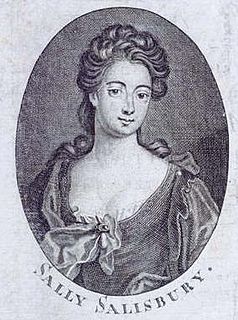
Sally Salisbury, real name Sarah Pridden and also known as Sarah Priddon, was a celebrated prostitute in early 18th-century London. She was the lover of many notable members of society, and socialised with many others.

Elizabeth Needham, also known as Mother Needham, was an English procuress and brothel-keeper of 18th-century London, who has been identified as the bawd greeting Moll Hackabout in the first plate of William Hogarth's series of satirical etchings, A Harlot's Progress. Although Needham was notorious in London at the time, little is recorded of her life, and no genuine portraits of her survive. Her house was the most exclusive in London and her customers came from the highest strata of fashionable society, but she eventually ran afoul of the moral reformers of the day and died as a result of the severe treatment she received after being sentenced to stand in the pillory.
François Benjamin Courvoisier was a Swiss-born valet who was convicted of murdering his employer Lord William Russell in London, England, and hanged outside Newgate Prison on 6 July 1840. A crowd of around 40,000 witnessed his death, including Charles Dickens and William Makepeace Thackeray.
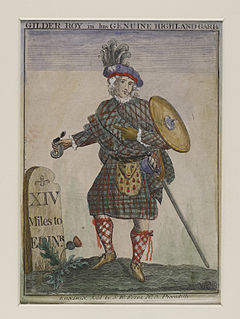
Best known as Gilderoy or Gilroy, Patrick McGregor was a Scottish outlaw and blackmailer who ravaged the lands of Strathspey, Braemar, Cromarty, and other areas in the vicinity of Aberdeen during the reign of Charles I (1600–1649). He is remembered in published stories, Scottish ballads, tunes, popular expressions, etc. Various other renderings of his name exist such as Gilder Roy and Gilleroy.
References
- 1 2 Brewer's Concise Dictionary of Phrase and Fable. London: Helicon Publishing. 1992. ISBN 1-85986-286-1.
- 1 2 3 "No. 2". The Spectator. 1711-03-02. Archived from the original on 7 September 2006. Retrieved 22 November 2006.
- ↑ "The Newgate Calendar: Davy Morgan". 1842. Retrieved 22 November 2006.